- Term Gymnosperm comes from the composite word in Greek: (Gymnos, ‘naked’ and sperma, ‘seed’), literally meaning ‘naked seeds‘- ovules are not enclosed by ovary wall
- Gymnosperms Similar to angiosperms in that they produce seeds
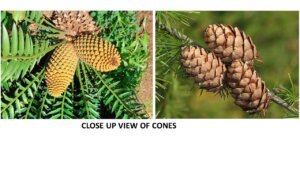
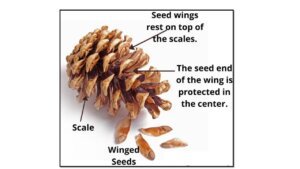
- The Gymnosperms are heterosporous:
- Produce two kinds of spores:
- Microspores and Megaspores
- These spores are produced within the sporangia
- Sporangia born on sporophylls
- Sporophylls are arranged spirally along an axis to form compact strobili or cones.
- Male cone/strobili bearing microsporangia
- Female cone/strobili bears megasporangia
- They do not produce flowers.
- Seeds are not formed inside a fruit. They are naked.
- They are found in colder regions where snowfall occurs.
- They develop needle-like leaves.
- They are perennial or woody, forming trees or bushes.
- They are not differentiated into ovary, style and stigma.
- Since stigma is absent, they are pollinated directly by the wind.
- The male gametophytes produce two gametes, but only one of them is functional.
- They form cones with reproductive structures.
- The seeds contain endosperm that stores food for the growth and development of the plant.
- These plants have vascular tissues which help in the transportation of nutrients and water.
- Xylem does not have vessels and the phloem has no companion cells and sieve tubes.
- All Gymnosperms are considered heterosporous
- Produce two types of spores: microspores and megaspores
- Examples: pine, spruce, fir, hemlock, ginkgo
- This category includes some of the most interesting plants including Giant sequoias, Redwood trees and Bristlecone pines
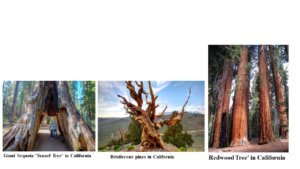
Four phyla of Gymnosperm
- Coniferophyta
- Ginkgophyta
- Cycadophyta
- Gnetophyta
Coniferophyta
- Most conifers are evergreen meaning their leaves remain throughout the year
- Most conifers are monoecious meaning they have separate male and female reproductive parts in different locations on the same plant.
- Different strobili or cones contain different types of spores to distinguish whether it is male or female.
- Exampels: Pinus wallichiana, Taxus baccata, Thuja jhao
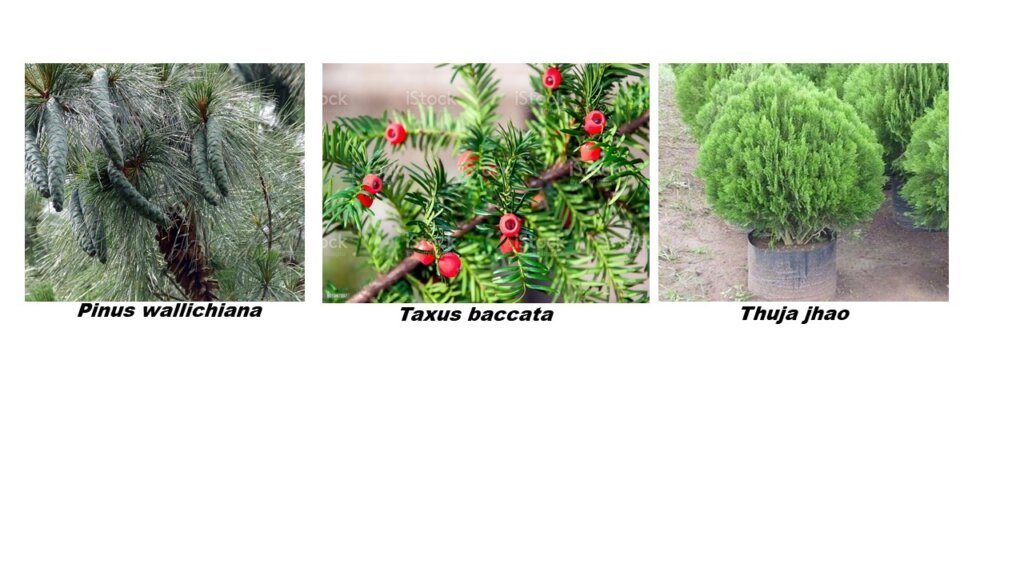
Cycadophyta
- Most species are extinct, but the ones that remain are tropical and subtropical plants
- Popular as ornamentals, therefore many species endangered
- Example: Cycas chamaoensis, Cycas revolute, Cycas Indica
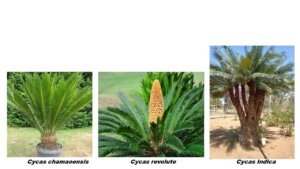
Ginkgophyta
- Only contains one living species: the ginkgo or maidenhair tree
- Named because of fan-shaped leaves resembling the maidenhair fern
- Is a species of tree native to China
- Oldest genus and species of living trees. Found to be at least 170 million years old
- Example: Ginko biloba
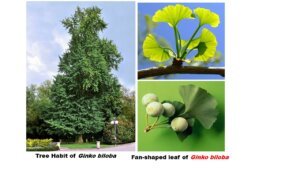
Gnetophytes
- Consists of some 70 species
- Contain more efficient water conducting cells in their xylem called vessel elements
- Cone clusters resemble flower clusters
- Some have seeds that are fleshy and resemble fruits from flowering plants
- Examples: Welwitschia mirabilis, Ephedra distachya, Gnetum gnemon
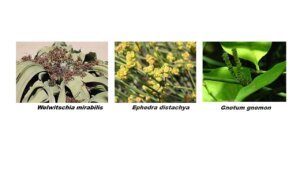
Ecological and Economic Importance
- Gymnosperms are a good source of food. Seeds of these plants are widely used as an edible species. These plant species include: ginko, pinus, cycas, etc.
- A few species of gymnosperms are a good source of starch and are also used in the production of sago. It serves as major staple food for lowland or indigenous peoples.
- In certain parts of America and in other lowland regions, the leaves of these plant species are soaked and eaten as a green leafy vegetable.
- The different species are widely used in the production of wine and also on other food products.
- Widely used by the pharmaceutical industry for the production of various medicines, to treat infectious disease and other allergies including cold, cough, asthma, bronchitis, etc.
- Taxus, a genus of coniferous trees is well known for the drug taxol. This is an anticancer drug.
- Cycas plants are used in the treatment of different diseases and also in the production of different hair care products, including oil, lotion, shampoo, etc.
- Oil extracted from the barks, wood and other parts of the plants are used in the cosmetics industries in the production of perfumes, room fresheners and other fragrance spray.
- Ornamental purpose: widely grown in gardens, parks and in other places as these plants possess beautiful ornamental leaves.
- Conifer forests provide stabilization of soil
- Trees used for christmas trees, timber, medicinal products, resins, and varnishes
References:
Singh V, Pandey PC, Jain DK (2014) A textbook of Botany. Rastogi Publication. Meerut, New Delhi, 5th revised edition
•https://www.nytimes.com/2017/01/09/us/pioneer-cabin-tree-sequoia.html •https://en.wikipedia.org/wiki/Cycas_indica •https://www.nccih.nih.gov/health/ginkgo
https://www.slideserve.com/tilden/gymnosperms-general-characteristics
•https://www.flickr.com/photos/adaduitokla/6241001749
Note:
This blog is for only study base. This blog has been made to consider for only students. Not for business purpose


After all, what a great site and informative posts, I will upload inbound link – bookmark this web site? Regards, Reader.
Thank you for sharing superb informations. Your web site is very cool. I am impressed by the details that you have on this web site. It reveals how nicely you understand this subject. Bookmarked this web page, will come back for more articles. You, my friend, ROCK! I found simply the info I already searched all over the place and just couldn’t come across. What a great site.
It’s onerous to find knowledgeable people on this matter, however you sound like you recognize what you’re speaking about! Thanks
Your point of view caught my eye and was very interesting. Thanks. I have a question for you. https://accounts.binance.com/en/register?ref=V2H9AFPY
Thanks! kindly inform me your question, I shall try my best
Thanks for your suggestion
I shall improve the spelling
excellent put up, very informative. I wonder why the other experts of this sector do not notice this. You must proceed your writing. I’m sure, you have a great readers’ base already!
Thank you!
Thanks for your good wards
the blog is prepared by myself only, no hiring the developer
very informative articles or reviews at this time.
Thanks!
Good post! We will be linking to this particularly great post on our site. Keep up the great writing
Thanks!
Thanks!
I shall try to write in short if it possible
We just wanted to take a moment to acknowledge all the hard work and effort you’ve been putting in lately. Keep up the amazing job, you’re doing great!
I just wanted to take a moment to say how much I appreciate your blog posts. They’re always well-written, informative, and keep me coming back for more. Keep up the great work!
This blog post is worth the read – trust us!
From start to finish, your content is simply amazing. You have a talent for making complex topics easy to understand and I always come away with valuable insights.
From start to finish, your content is simply amazing. You have a talent for making complex topics easy to understand and I always come away with valuable insights.
Every time I read one of your posts, I come away with something new and interesting to think about. Thanks for consistently putting out such great content!
Hello i think that i saw you visited my weblog so i came to Return the favore Im trying to find things to improve my web siteI suppose its ok to use some of your ideas